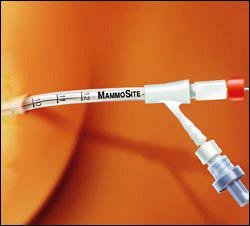 Women who opt for brachytherapy following breast conserving surgery face a greater risk of needing a mastectomy in the future than those who chose whole-breast irradiation. These findings were presented at the recent San Antonio Breast Cancer Symposium
Women who opt for brachytherapy following breast conserving surgery face a greater risk of needing a mastectomy in the future than those who chose whole-breast irradiation. These findings were presented at the recent San Antonio Breast Cancer Symposium
According to the study investigators, five years after initial treatment, women who opted for brachytherapy had a 4% mastectomy rate compared with 2.2% among women who received radiation to the entire breast.
For those who have not had breast conserving surgery, the role of radiation following surgery is to kill off any possible remaining cancer cells in the breast. Radiation is done to help prevent a recurrence, or return, of breast cancer and can be given with external or internal radiation.
External beam radiation, also called whole-breast irradiation (WBI), treats the whole breast from the outside, by aiming highly penetrating x-rays at your tumor cavity. It begins four to six weeks after surgery. Patients receive one treatment a day for six to seven weeks. It is very successful in preventing recurrence of cancer in the breast, but many women find the long duration of treatment and side effects such as exhaustion a burden.
Brachytherapy is another option which has been gaining in popularity over the past several years. In breast brachytherapy radiation sources such as tiny pellets the size of pencil lead are placed inside an area that may contain residual cancer after surgical removal of the visible tumor mass.
Brachytherapy is appealing to many women with early stage breast cancer as it only takes one week to administer as opposed to six weeks with whole-breast irradiation.
Use of breast brachytherapy increased from fewer than 1% of early breast cancer cases in 2000 to 13% in 2007, which was the period covered by the study.
Benjamin D. Smith, MD, of MD Anderson Cancer Center in Houston, reported, “Our findings show that there are tradeoffs involved in the selection of a radiation therapy technique, and patients need to be aware of these tradeoffs.” He added that the findings in this study emphasize the need to wait for mature data from randomized clinical trials before widespread use of brachytherapy for early breast cancer.”
Smith and colleagues presented results from a retrospective review of outcomes for women who had partial breast irradiation with brachytherapy or whole-breast irradiation. They used Medicare claims data to identify all patients older than 66 with newly diagnosed invasive breast cancer during the study period.
The analysis included 130,535 women. Patients who had breast brachytherapy tended to be older and white; were less likely to have lymph node involvement or to have received chemotherapy.
Over 9%9 of brachytherapy patients needed hospitalization during follow-up, compared with 5.7% among women who had whole-breast irradiation. The brachytherapy group also had a higher infection rate (8.1% versus 4.5%).
The cumulative five-year incidence of several other complications occurred more often in women treated with breast brachytherapy, including rib fracture (4.2% versus 3.7%), fat necrosis (9.1% versus 3.7%), and breast pain (14.9% versus 11.7%). Pneumonitis occurred more often among women who had whole-breast irradiation (0.8% versus 0.1%).
Smith acknowledged that a major limitation of the study was the fact that the time period reviewed represented early clinical experience with breast brachytherapy. Repeating the study and limiting the review to later experience might have changed the results.
 Women who opt for brachytherapy following breast conserving surgery face a greater risk of needing a mastectomy in the future than those who chose whole-breast irradiation. These findings were presented at the recent San Antonio Breast Cancer Symposium
Women who opt for brachytherapy following breast conserving surgery face a greater risk of needing a mastectomy in the future than those who chose whole-breast irradiation. These findings were presented at the recent San Antonio Breast Cancer Symposium
